Cats' ability to leap with such grace and precision has long fascinated researchers and cat enthusiasts alike. Understanding the biomechanics behind these agile creatures' jumps opens a window into their evolutionary past and instinctual behaviors.
From the intricate interplay of muscles and nerves to the remarkable heights they can achieve, the world of feline leaping feats is a captivating realm waiting to be explored.
Whether for survival in the wild or playful exploration in our homes, the secrets behind cats' jumps continue to intrigue and astound.
Key Takeaways
- Cats' jumping abilities stem from ancestral traits and specialized muscles.
- Understanding cats' need to jump helps provide safe and stimulating environments.
- Safety measures like avoiding heated surfaces and providing suitable props ensure cats' well-being.
- Encouraging appropriate jumping behaviors through training enhances cats' natural instincts.
Evolution of Cats' Jumping Abilities
The evolutionary development of cats' jumping prowess can be attributed to their ancestral roots in tree-dwelling wildcats, which endowed them with remarkable leaping abilities. Cats, having descended from North African/Near Eastern wildcats with tree-dwelling habits, have retained key anatomical features that support their exceptional jumping skills. These features include strong hind legs, fast twitch muscle fibers, and over 500 muscles engaged during a leap.
Additionally, cats' paws possess nerve receptors that aid in maintaining balance and assessing jump surfaces, contributing to their agility and precision in landing. This evolutionary adaptation has enabled cats to jump up to 5-6 times their body length vertically, showcasing their natural athleticism and survival instincts inherited from their wild ancestors.
Anatomical Features Supporting Cats' Jumps
Evolution has honed cats' anatomical structures to efficiently support their impressive jumping abilities. Cats possess powerful hind leg muscles, particularly the gastrocnemius and soleus muscles, which provide explosive propulsion during jumps. Their flexible spine and strong pelvic muscles further aid in achieving great heights.
Cats' long tails serve as a balancing mechanism, enabling mid-air adjustments for precise landings. Additionally, specialized paw pads equipped with nerve receptors enhance grip and stability on various surfaces. These anatomical adaptations, inherited from their wildcat ancestors, contribute to cats' remarkable agility and vertical prowess.
Understanding these features sheds light on the biomechanics behind cats' extraordinary leaping feats.
Muscular Mechanics of Cat Leaps
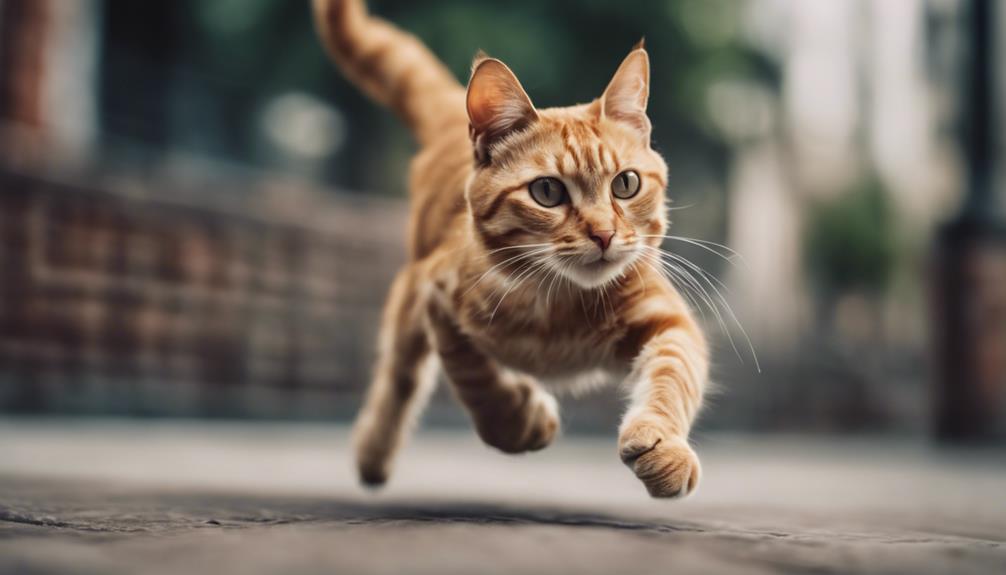
Efficient utilization of powerful hind leg muscles and specialized nerve receptors in their paws enables cats to execute precise and powerful leaps. The hind leg muscles provide the necessary strength and propulsion for the jump, allowing cats to spring into action swiftly.
Cats' fast-twitch muscle fibers play a crucial role in generating the explosive force needed for their impressive vertical and horizontal jumps. These muscles contract rapidly, producing rapid movements that propel the cat into the air.
Additionally, the coordination between the muscles and nerve receptors in their paws ensures a stable and accurate landing, essential for maintaining balance and executing seamless transitions between jumps. The intricate interplay of these muscular mechanics showcases the remarkable agility and precision of cats in their leaping feats.
Nerve Receptors and Balance in Jumping
In understanding cats' remarkable jumping abilities, a crucial aspect to consider is the intricate interplay between their nerve receptors and sense of balance during leaps. Cats rely on a sophisticated system of nerve receptors in their paws and inner ears to maintain stability and accurately gauge distances when jumping. This sensory feedback loop contributes significantly to their precise and graceful movements in the air.
Key points to note about nerve receptors and balance in cats' jumping are:
- Nerve receptors in cats' paws provide tactile feedback.
- Inner ear receptors help cats maintain equilibrium mid-air.
- Rapid communication between nerve receptors and brain aids in quick adjustments.
- Enhanced balance capabilities allow cats to land gracefully after jumps.
Vertical Jumping Records in Cats
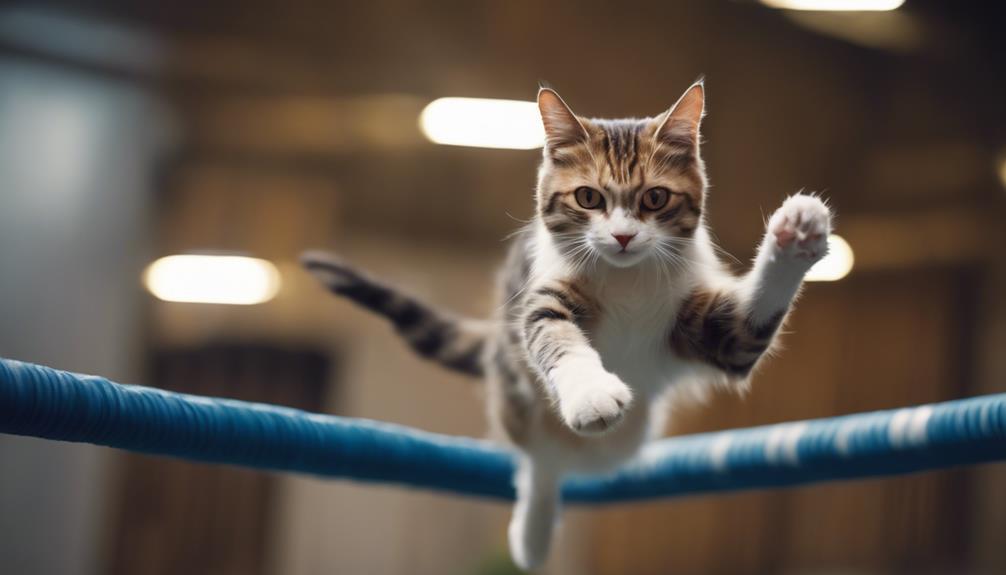
With their exceptional physical capabilities and ancestral instincts, cats have achieved impressive vertical jumping records. Healthy adult cats can jump up to 5-6 times their body length vertically, which is about 8 feet.
The Guinness World Record for the longest jump by a cat stands at an astounding 7 feet, showcasing the remarkable jumping prowess of these feline creatures. Certain cat breeds such as Abyssinians and Savannahs are known for their exceptional jumping abilities, pushing the boundaries of what is thought possible for domestic cats.
These records not only highlight the agility and strength of cats but also underline the importance of providing them with opportunities to exercise and express their natural behaviors in a safe and stimulating environment.
Horizontal Jumping Capabilities of Cats
Considering cats' remarkable vertical jumping abilities, it is intriguing to explore the extent of their horizontal jumping capabilities. Cats exhibit impressive agility and strength in their horizontal jumps, showcasing another dimension of their athletic prowess.
When it comes to horizontal jumping, cats demonstrate exceptional skills that are vital for their survival instincts and daily activities. The following aspects shed light on cats' horizontal jumping capabilities:
- Precision in targeting landing spots.
- Quick acceleration and deceleration in mid-air.
- Ability to adjust trajectory based on obstacles.
- Utilization of tail for balance and stabilization.
Breeds Known for Impressive Jumps
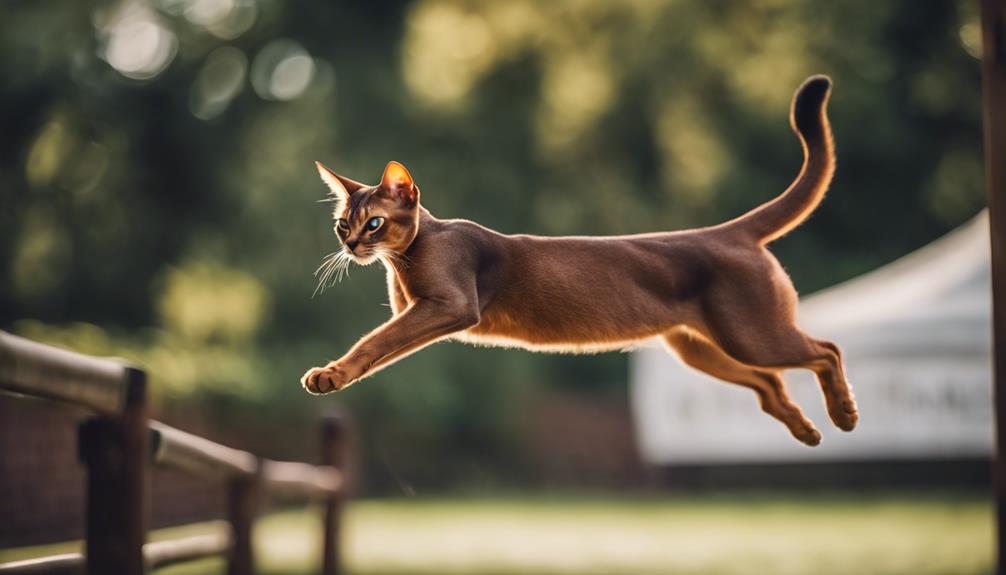
Several cat breeds are recognized for their exceptional jumping abilities, showcasing remarkable athleticism and agility. The Abyssinian breed is known for its impressive vertical leaps, often reaching heights that astonish onlookers. This breed's strong hind legs and muscular build contribute to its remarkable jumping prowess.
Additionally, the Savannah breed, a cross between a domestic cat and a serval, is also celebrated for its extraordinary jumping abilities. Savannah cats possess a wildcat-like athleticism that allows them to leap great distances both vertically and horizontally.
These breeds, along with others such as the Bengal and Somali, demonstrate the diversity of feline jumping capabilities within the world of domestic cats.
Instinctual Reasons for Cat Jumping
Cats' natural instincts drive their frequent and purposeful jumping behaviors, reflecting their ancestral heritage as agile hunters and climbers. This innate behavior serves various purposes for cats, such as:
- Seeking high perches for safety, observation, and curiosity.
- Establishing a feeling of safety and gaining vantage points.
- Following a natural instinct passed down from wildcat ancestors.
- Providing cats with a sense of control over their environment.
These instincts play a crucial role in a cat's daily life, influencing their choices in navigating their surroundings and seeking comfort and security in elevated locations.
Creating Safe Jumping Environments
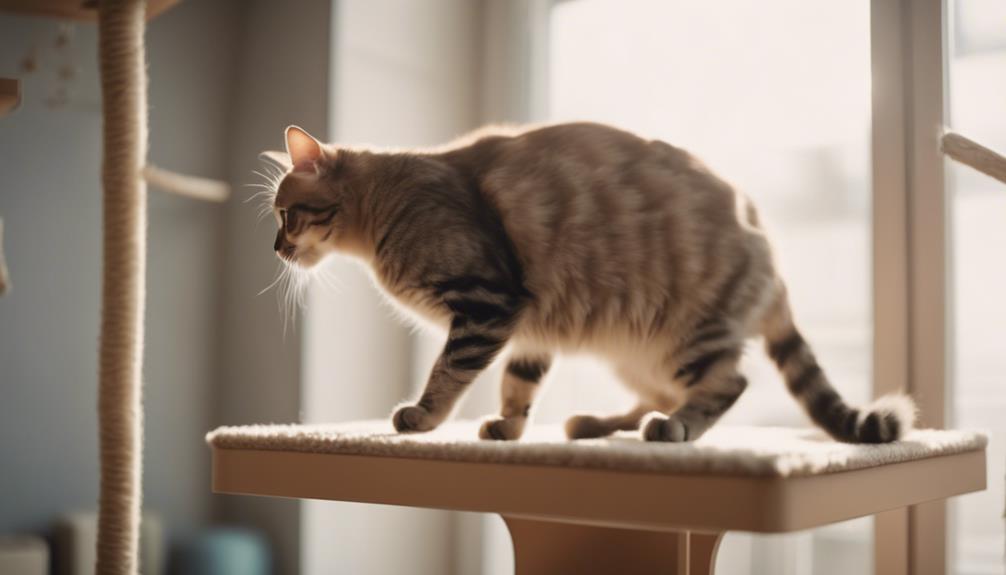
In ensuring the well-being of feline companions, it is essential to establish secure environments that cater to their natural inclination for jumping and perching. Creating safe jumping environments for cats involves considering their physical limitations and providing suitable structures.
Cats should not be allowed to jump onto surfaces near heated appliances to prevent accidents. Safety measures should include age-appropriate accessibility for cats' jumping needs and the provision of supportive props like pet stairs for older cats.
Positive reinforcement clicker training can guide cats to suitable high spots, while teaching them to avoid off-limits areas for leaps and bounds. Building cat trees with safety in mind and providing cat shelves for high-up perches are additional measures to enhance the safety of cats' jumping environments.
Training Techniques for Cat Jumps
To enhance your cat's jumping abilities, implement effective training techniques that focus on improving their agility and confidence in leaping. Training your cat to jump can be both fun and beneficial for their physical and mental health. Here are some techniques to help your feline friend become a proficient jumper:
- Use Interactive Toys: Engage your cat in play sessions that involve jumping to catch toys.
- Set Up Agility Courses: Create obstacle courses with hurdles and platforms to encourage jumping.
- Reward Positive Behavior: Use treats and praise to reinforce successful jumps.
- Gradual Progression: Start with lower heights and gradually increase the difficulty to build your cat's jumping skills.
Resources for Cat Jumping Enthusiasts
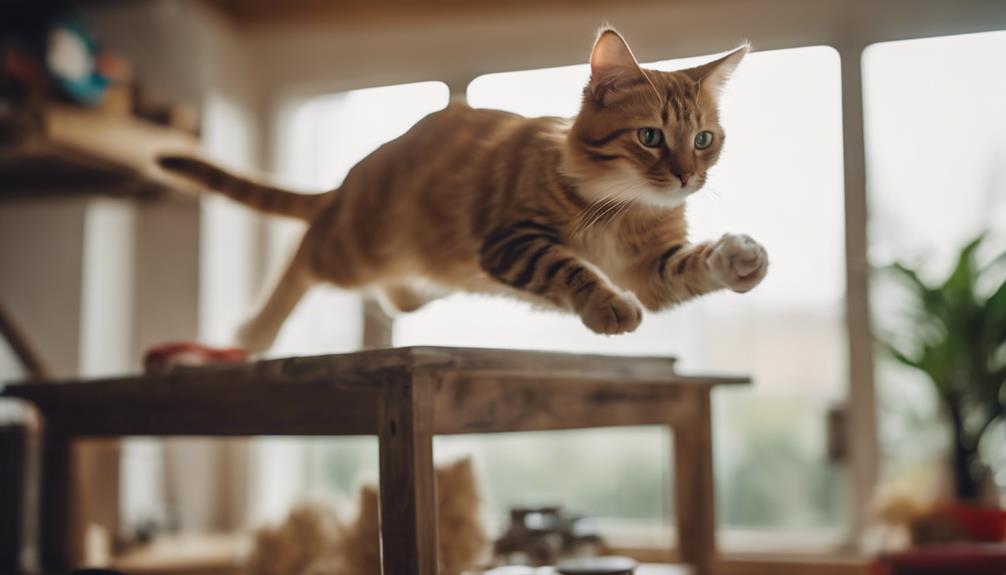
For those passionate about feline athleticism, a comprehensive guide to enhancing cats' jumping skills can offer valuable insights and practical tips. Cat jumping enthusiasts can explore various resources to further develop their understanding and support their cats' natural abilities.
Online platforms like Catster and The Cat Site provide articles, forums, and expert advice on training techniques, equipment, and cat behavior related to jumping. Books such as 'The Trainable Cat' by John Bradshaw and Sarah Ellis offer in-depth knowledge on cat training methods, including jumping exercises.
Additionally, attending workshops or seminars on feline behavior and training can provide hands-on experience and personalized guidance for cat owners looking to optimize their cats' jumping prowess.
Frequently Asked Questions
Can Cats Learn to Improve Their Jumping Abilities Through Training Techniques?
Cats can enhance jumping abilities through focused training techniques. Positive reinforcement methods, like clicker training, can guide cats to improve their leaps safely. Understanding individual cat breed characteristics and providing appropriate support can aid in optimizing their jumping skills.
Are There Any Specific Exercises or Games That Can Help Enhance a Cat's Jumping Skills?
To enhance a cat's jumping skills, incorporate interactive toys like feather teasers or laser pointers to encourage leaping. Use cat trees or shelves for vertical exploration. Provide platforms at varying heights to stimulate their natural climbing and jumping instincts.
How Do Factors Like Age and Weight Impact a Cat's Jumping Capabilities?
Age and weight can impact a cat's jumping capabilities. Younger, lighter cats may exhibit higher and more agile leaps compared to older or heavier felines. Healthy weight management, exercise, and environmental enrichment can support cats' jumping abilities as they age.
Are There Any Special Considerations for Indoor Cats to Maintain Their Natural Jumping Instincts?
Special considerations for indoor cats to maintain their natural jumping instincts include providing safe and accessible high perches, encouraging climbing activities, using positive reinforcement for training, and ensuring age-appropriate support like pet stairs.
Can Certain Health Conditions or Disabilities Affect a Cat's Jumping Prowess and How Can Owners Accommodate These Challenges?
Certain health conditions or disabilities can impact a cat's jumping prowess. Owners can accommodate these challenges by providing lower surfaces for easy access, using ramps or steps, offering interactive toys for mental stimulation, and consulting a veterinarian for tailored advice.
Do Cats with Hip Dysplasia Have Difficulty with Leaping and Jumping?
Cats with signs of hip dysplasia may experience difficulty with leaping and jumping. This condition can cause pain and discomfort, making it challenging for them to perform these activities. It’s important for pet owners to watch for signs of hip dysplasia in cats and seek proper veterinary care.
Conclusion
In conclusion, understanding the evolutionary and anatomical factors that contribute to cats' impressive jumping abilities sheds light on the importance of creating safe and enriching environments for our feline companions.
By recognizing the instinctual reasons behind cat jumping behavior and employing training techniques and resources, we can enhance their jumping experiences and deepen our appreciation for these acrobatic animals.
Creating a conducive environment for cats to fulfill their natural instincts is essential for their well-being and overall happiness.




